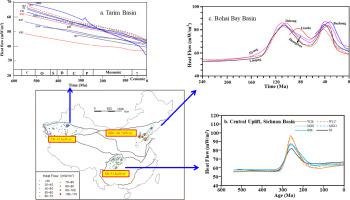Earth-Science Reviews ( IF 12.1 ) Pub Date : 2021-12-06 , DOI: 10.1016/j.earscirev.2021.103884 Nansheng Qiu 1, 2 , Jian Chang 1, 2 , Chuanqing Zhu 1, 2 , Wen Liu 1, 2 , Yinhui Zuo 1, 3 , Wei Xu 1, 4 , Dan Li 1, 2

|
Thermal regime and thermal history are of significant important in basin dynamics and hydrocarbon generation of source rocks. The sedimentary basins in three typical cratons of China, North China Craton (NCC), Yangtze Craton (YC) and Tarim Craton (TC), underwent completely different tectonic background and dynamic mechanism, which resulted in the differentials of their thermal regimes. In this paper, the thermal regimes of the Bohai Bay Basin in the eastern NCC, Tarim Basin in TC, and Sichuan basin in the Upper YC were studied. There has some lower thermal background in the area of western China than eastern side of the NCC. The mean heat flow value of Tarim basin is 42.5 mW/m2, 53.8 mW/m2 in the Sichuan basin and 66.7 mW/m2 in the eastern NCC. And the temperature at 10000 m ultra-depth in the Tarim Basin also shows lower values than that of Sichuan and Bohai Bay basins. The thermal history, modeled from thermal indicators of vitrinite reflectance (Ro), equivalent vitrinite reflectance data (Requ), fission track and (U Th)/He data of apatite and zircon, evolved differently because of the different tectonic history in these basins. The Tarim basin underwent a cooling history with the heat flow of 55–65 mW/m2 in the Cambrian decreasing to the present-day of 40–50 mW/m2. The Meso-Cenozoic thermal history of the Bohai Bay basin experienced four evolutionary stages with two heat flow peaks in the late Early Cretaceous and in the Middle to Late Paleogene, which correspond to the destruction peaks of the eastern NCC and had heat flow values of 82–86 mW/m2 and 81–88 mW/m2, respectively. The Sichuan basin was stable with heat flow value of less than 65 mW/m2 from the Late Sinian to Late Paleozoic, and the heat flow increased rapidly to the peak value (75–100 mW/m2) at the end of Early Permian by thermal effect of the Emeishan mantle plume. From Mesozoic to present, the heat flow decreased to the present value (60–70 mW/m2). In addition, the comparation of thermal characteristics of typical cratons around the world, including heat flow, thermal history, lithospheric thermal structure and thermal lithospheric thickness, also have been caried out. The differential thermal histories of Tarim and Sichuan basins resulted in the different thermal evolution of Cambrian source rocks. This study may provide some new geothermal evidence for hydrocarbon generation and phase distribution of oil and gas in the deep and/or ultra-deep basin.
Th)/He data of apatite and zircon, evolved differently because of the different tectonic history in these basins. The Tarim basin underwent a cooling history with the heat flow of 55–65 mW/m2 in the Cambrian decreasing to the present-day of 40–50 mW/m2. The Meso-Cenozoic thermal history of the Bohai Bay basin experienced four evolutionary stages with two heat flow peaks in the late Early Cretaceous and in the Middle to Late Paleogene, which correspond to the destruction peaks of the eastern NCC and had heat flow values of 82–86 mW/m2 and 81–88 mW/m2, respectively. The Sichuan basin was stable with heat flow value of less than 65 mW/m2 from the Late Sinian to Late Paleozoic, and the heat flow increased rapidly to the peak value (75–100 mW/m2) at the end of Early Permian by thermal effect of the Emeishan mantle plume. From Mesozoic to present, the heat flow decreased to the present value (60–70 mW/m2). In addition, the comparation of thermal characteristics of typical cratons around the world, including heat flow, thermal history, lithospheric thermal structure and thermal lithospheric thickness, also have been caried out. The differential thermal histories of Tarim and Sichuan basins resulted in the different thermal evolution of Cambrian source rocks. This study may provide some new geothermal evidence for hydrocarbon generation and phase distribution of oil and gas in the deep and/or ultra-deep basin.



























 京公网安备 11010802027423号
京公网安备 11010802027423号